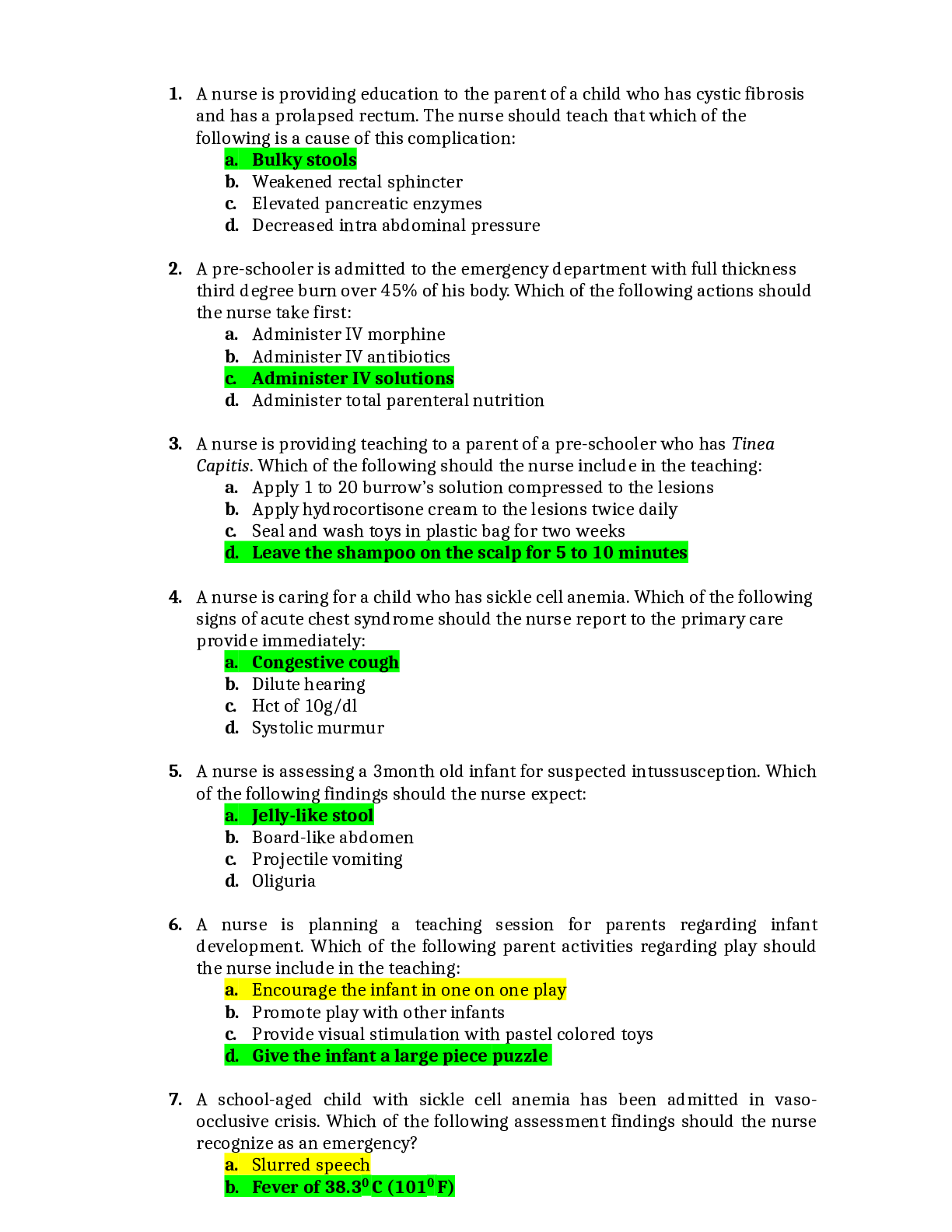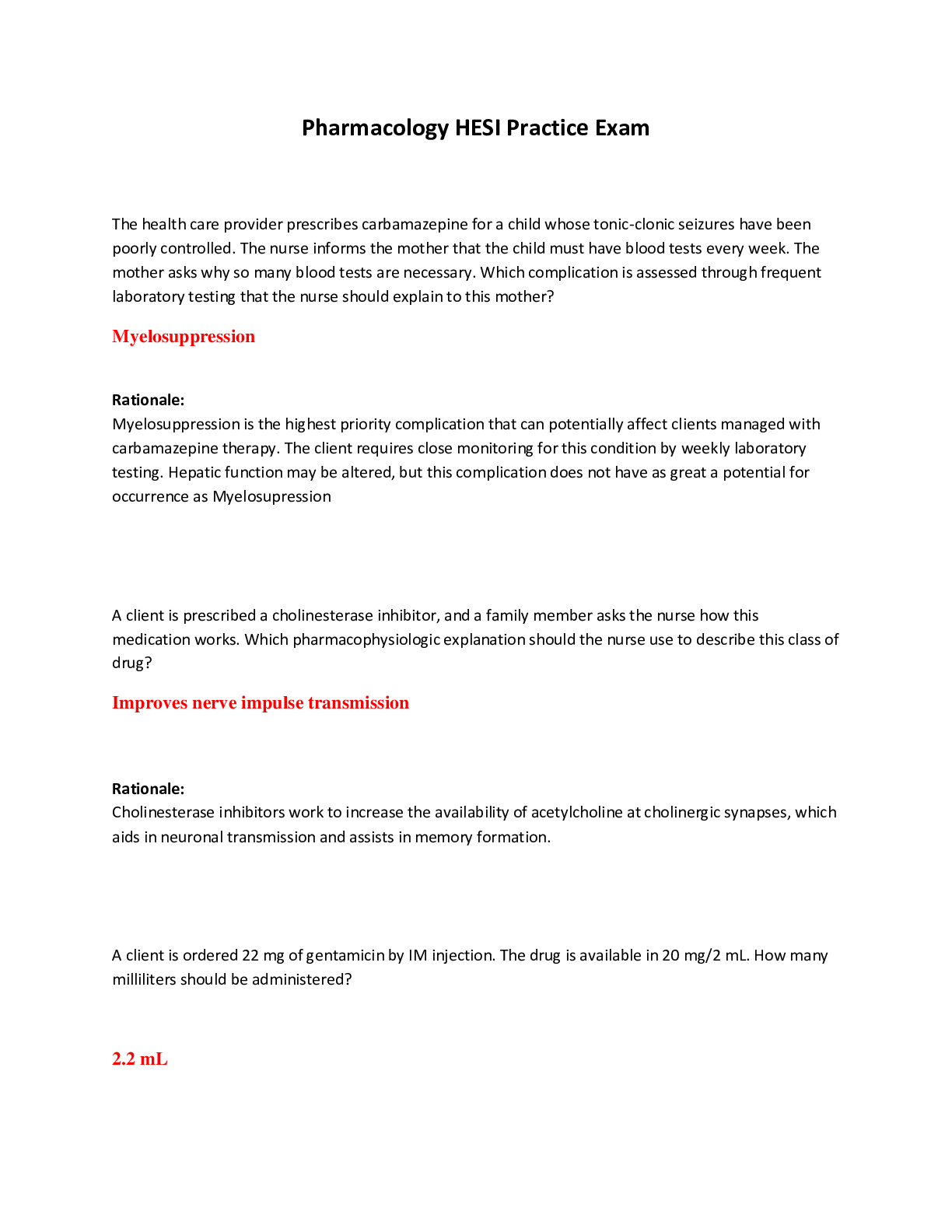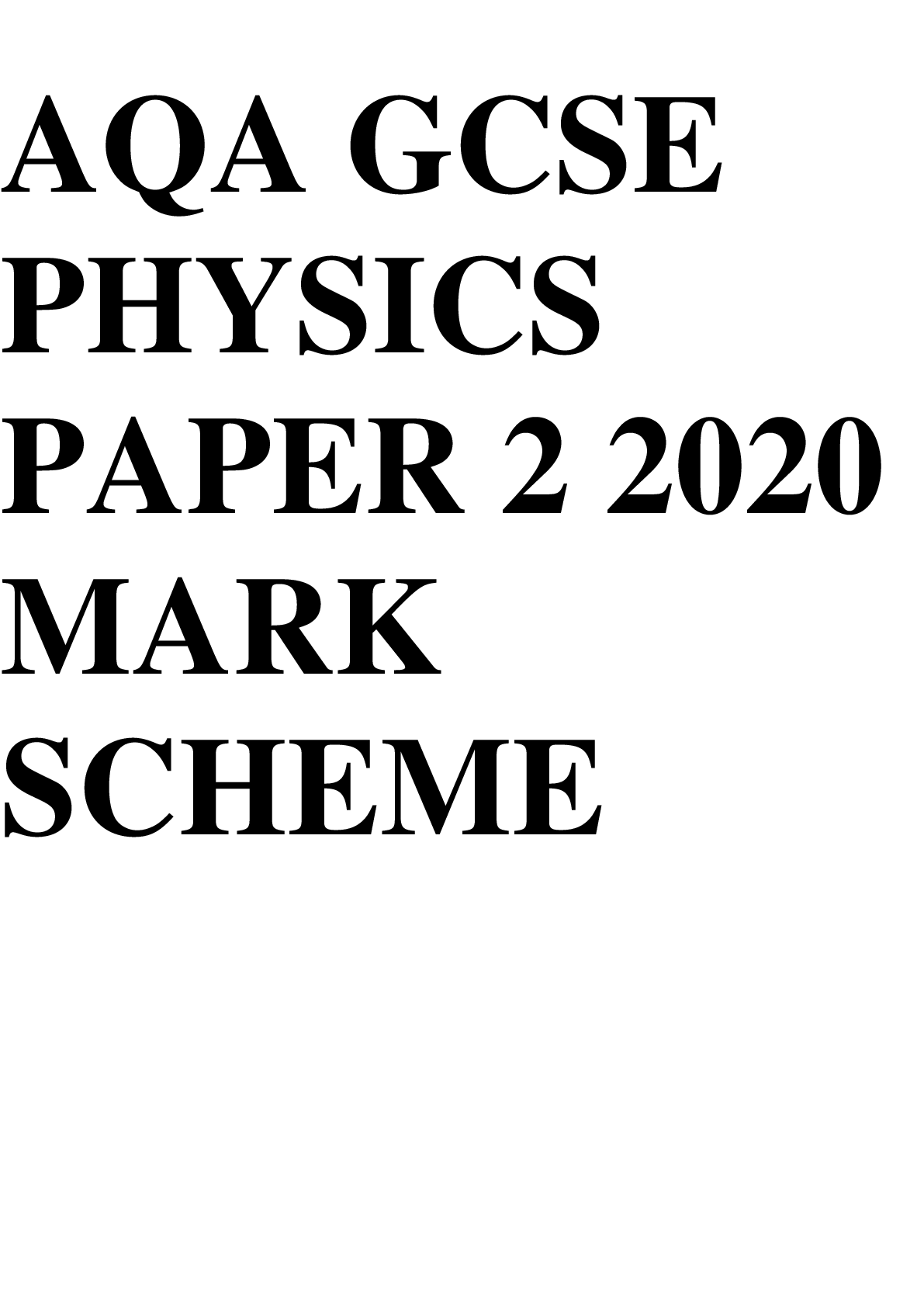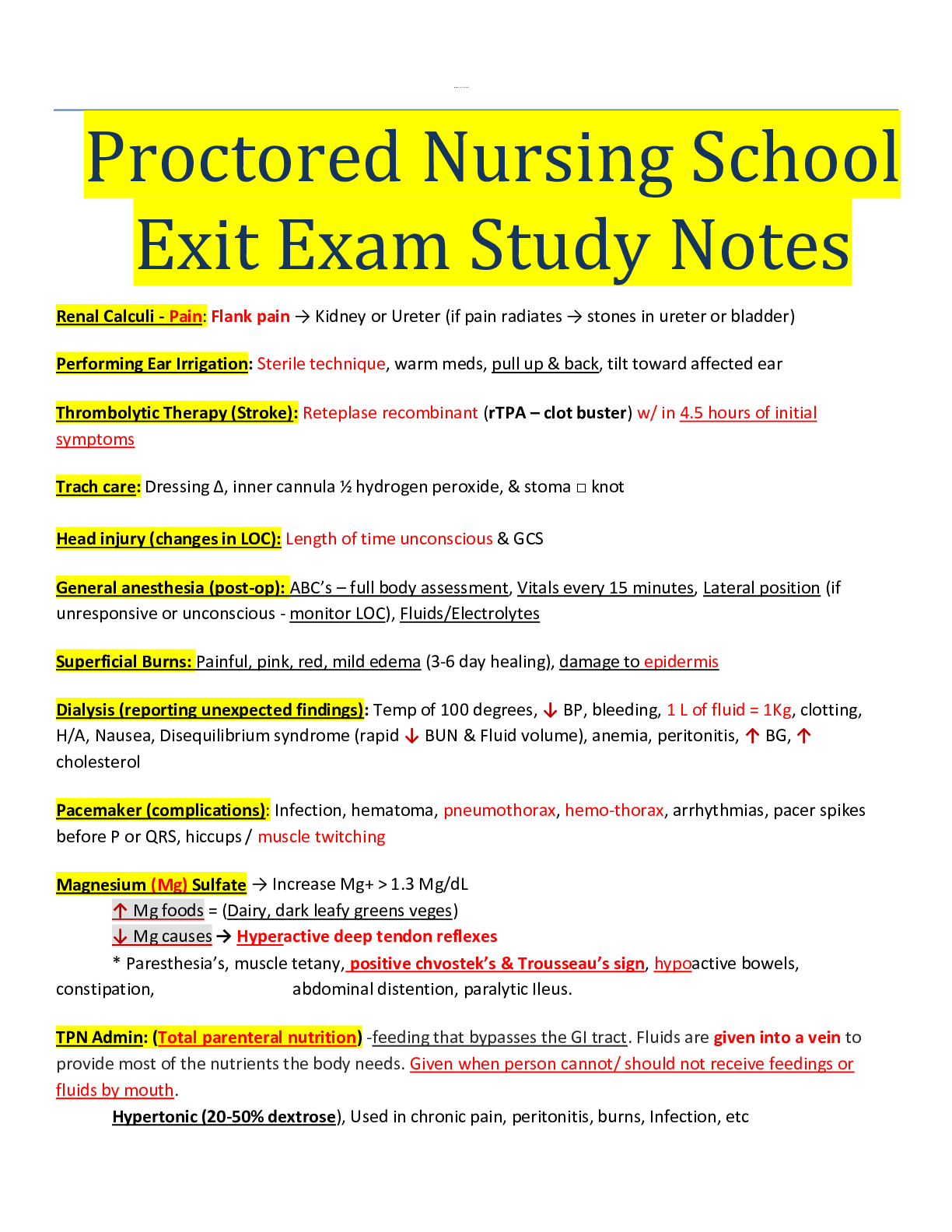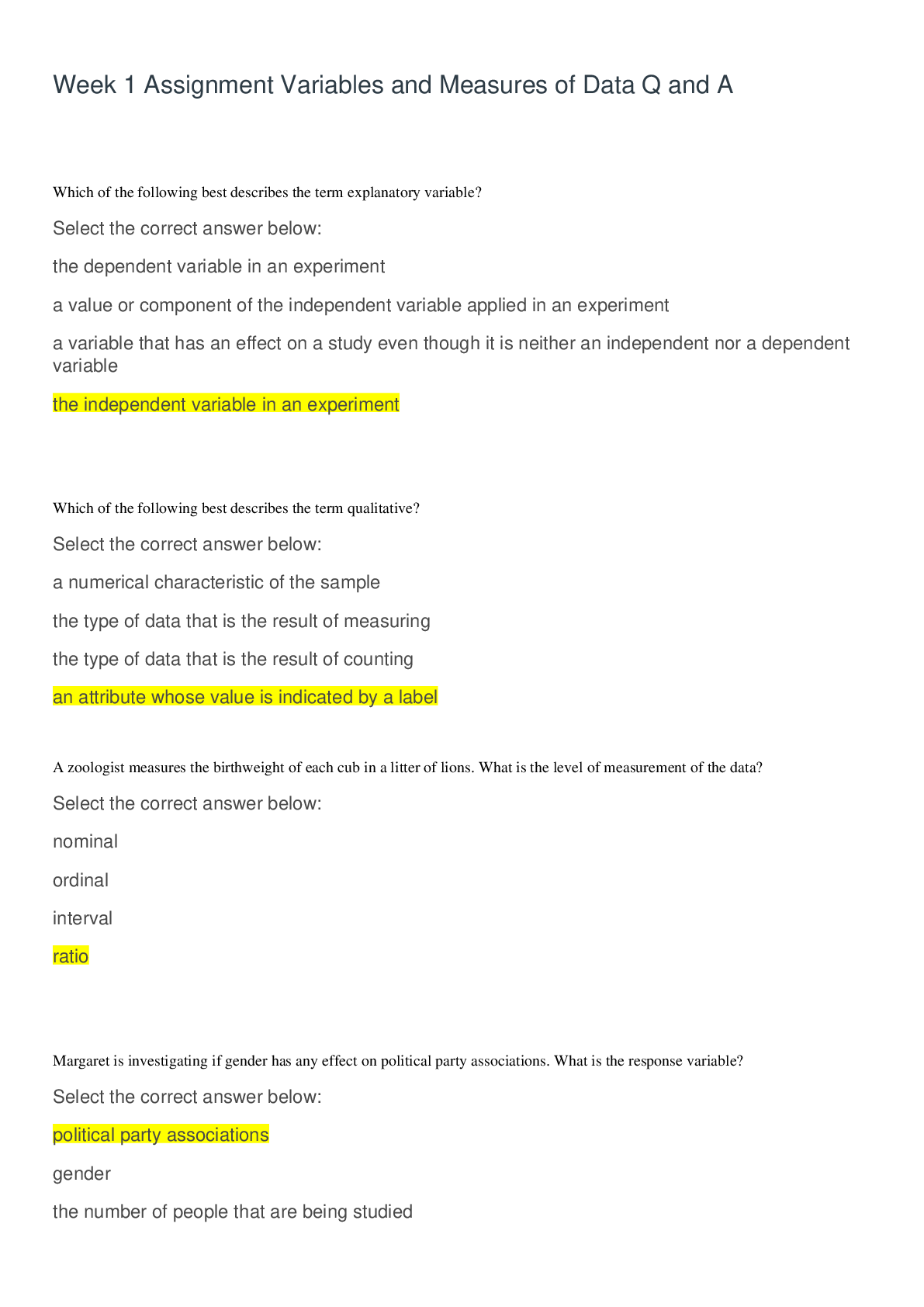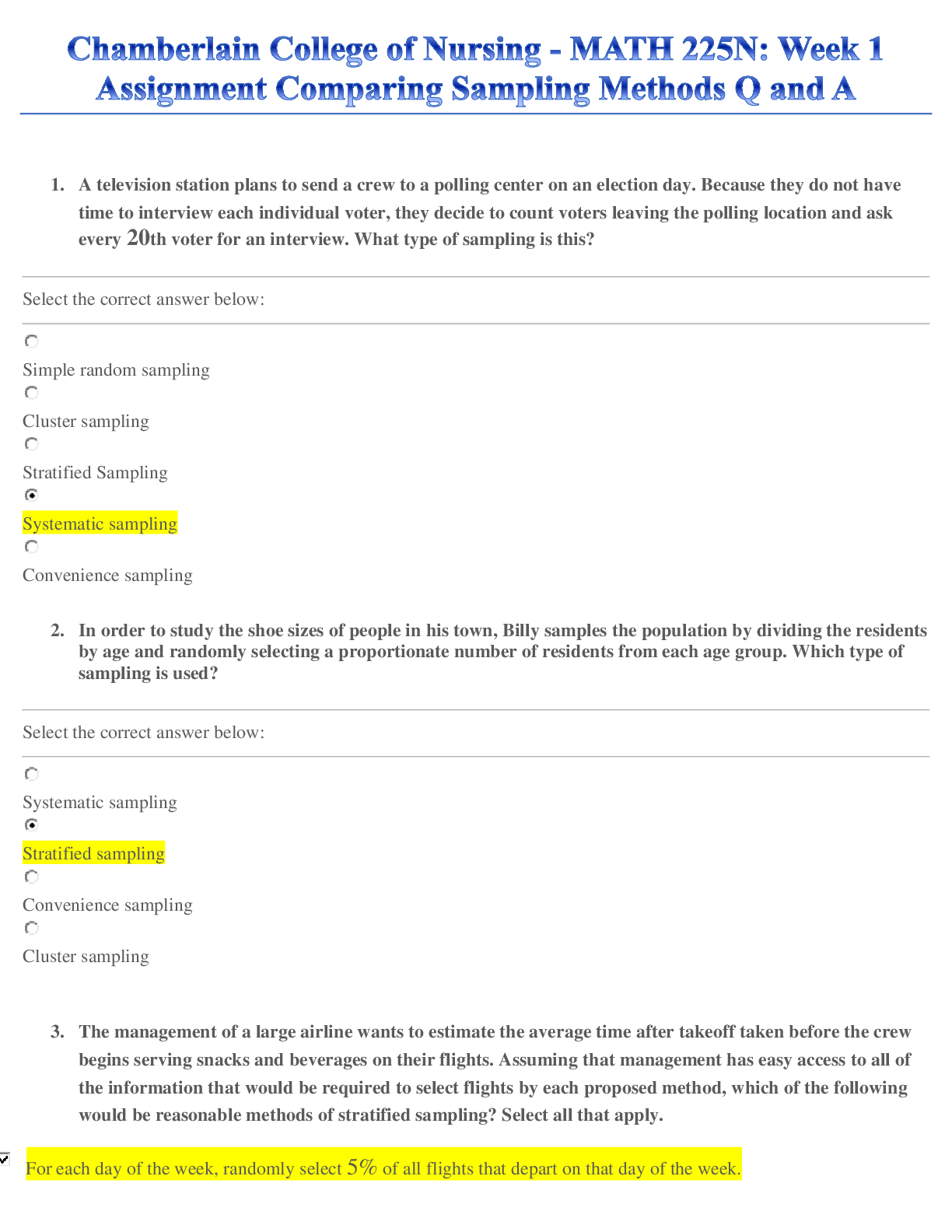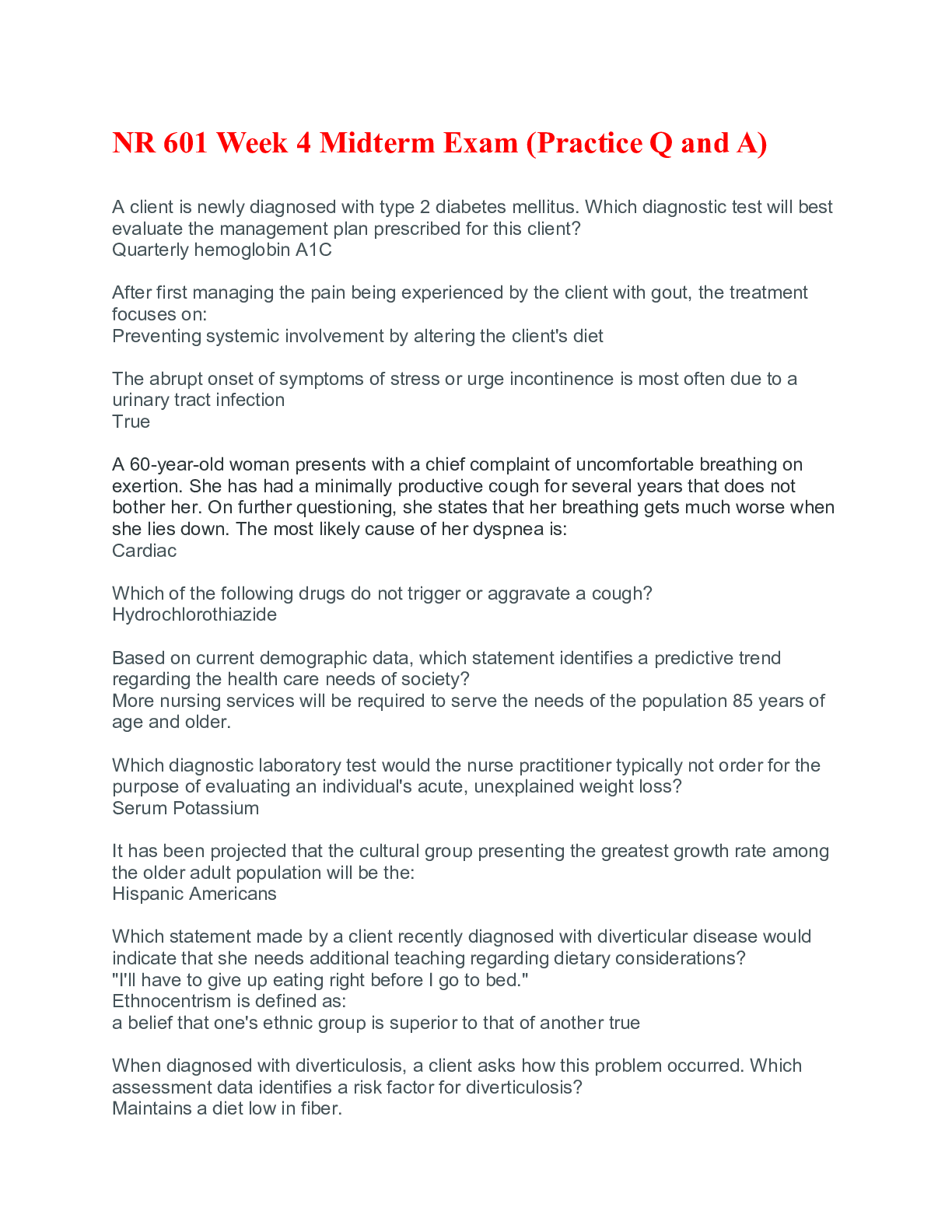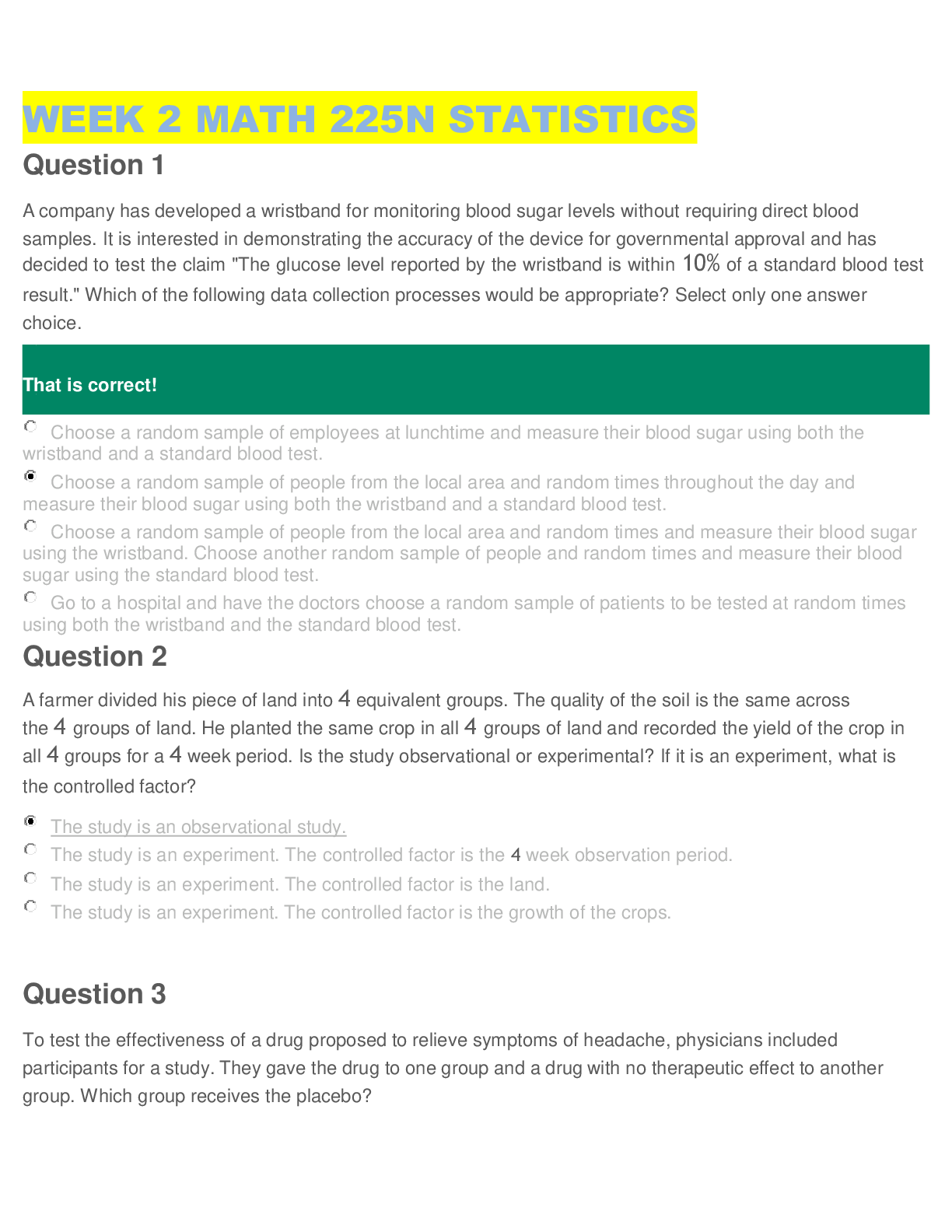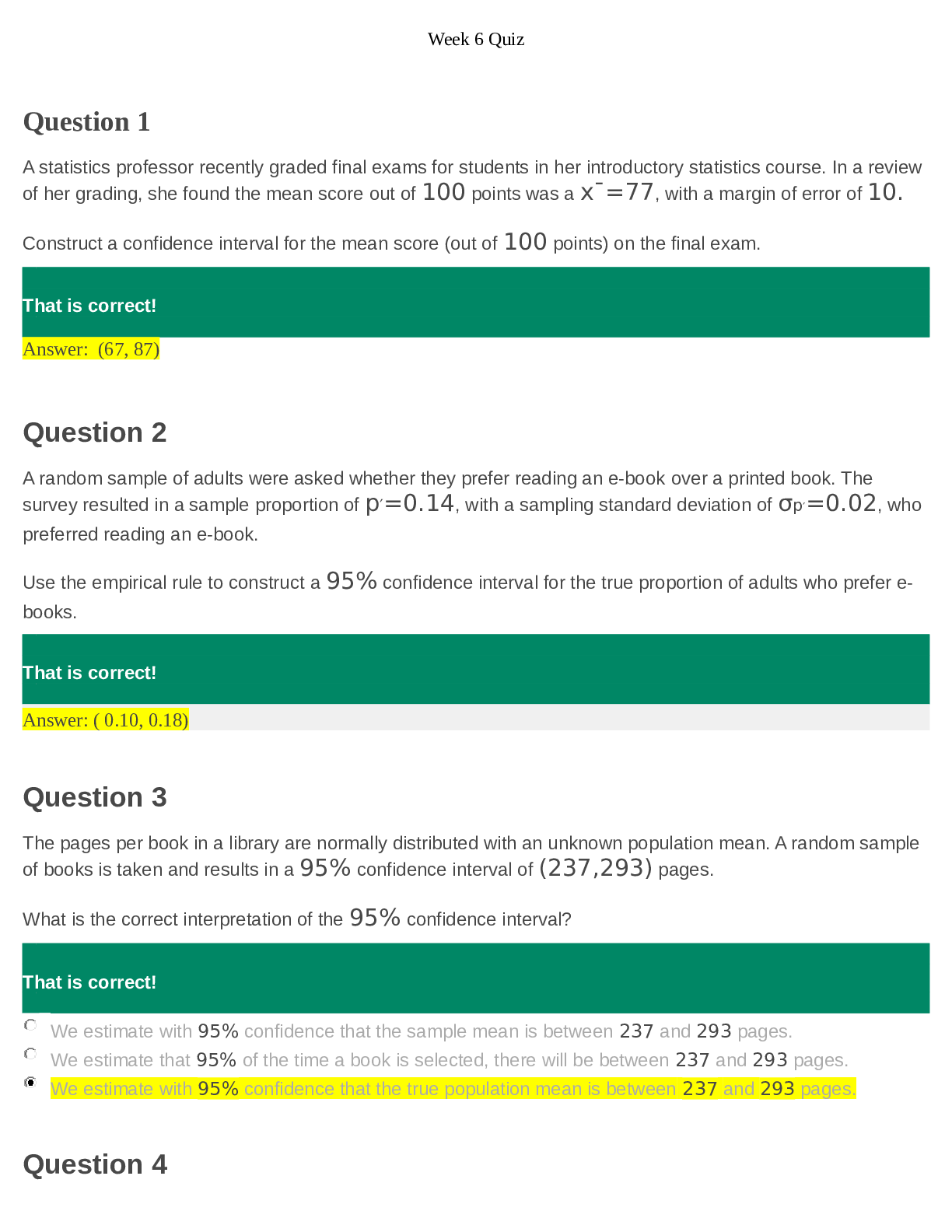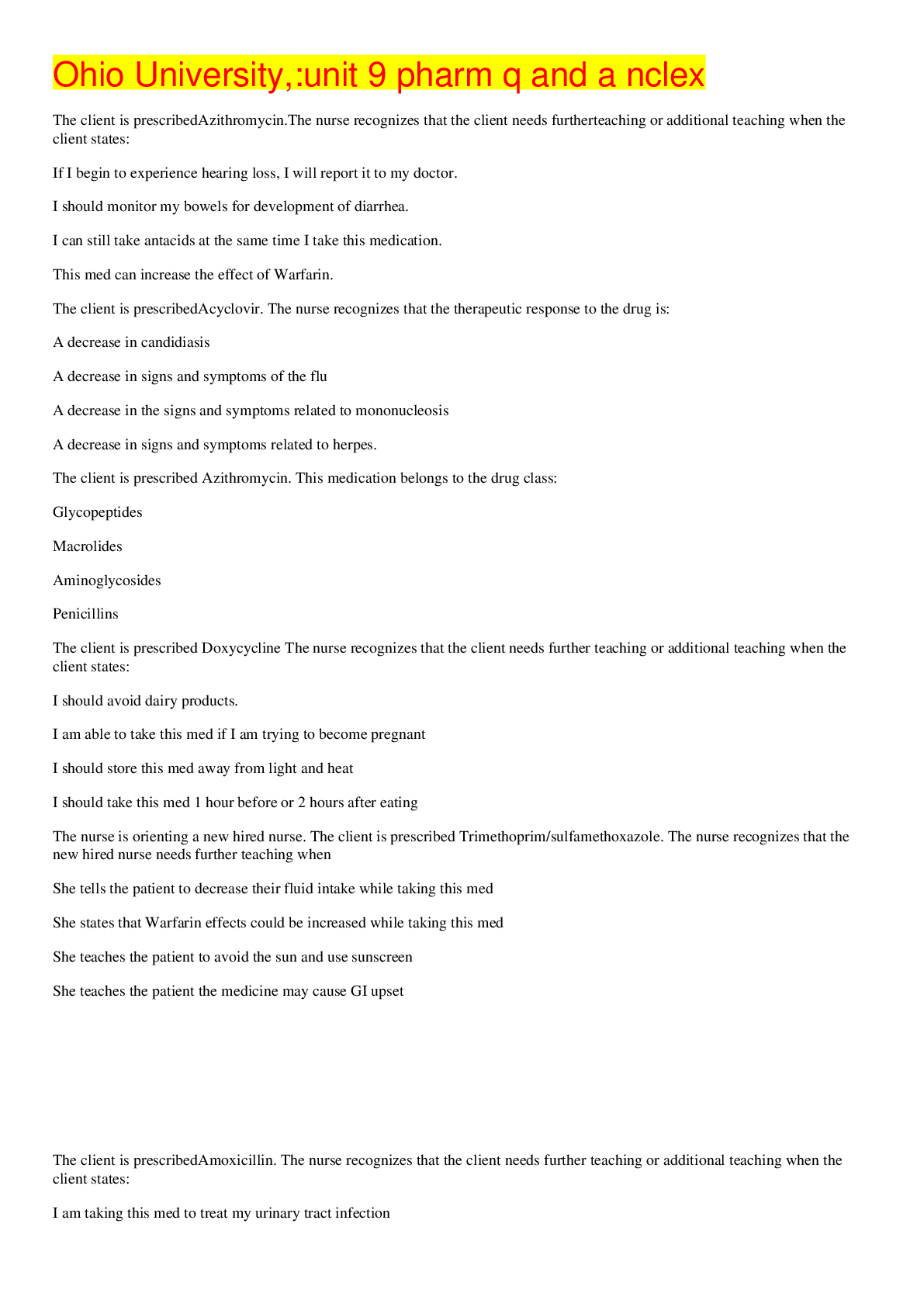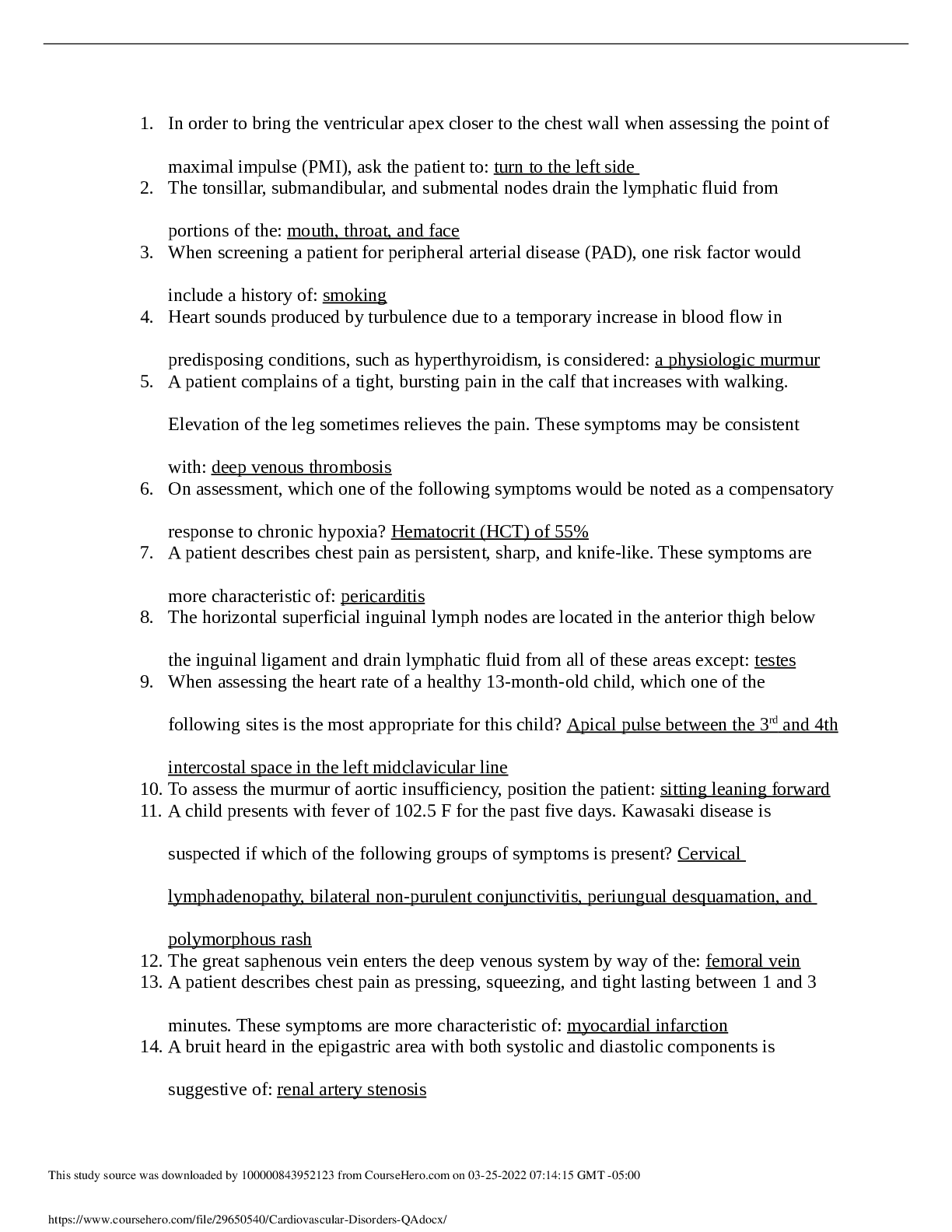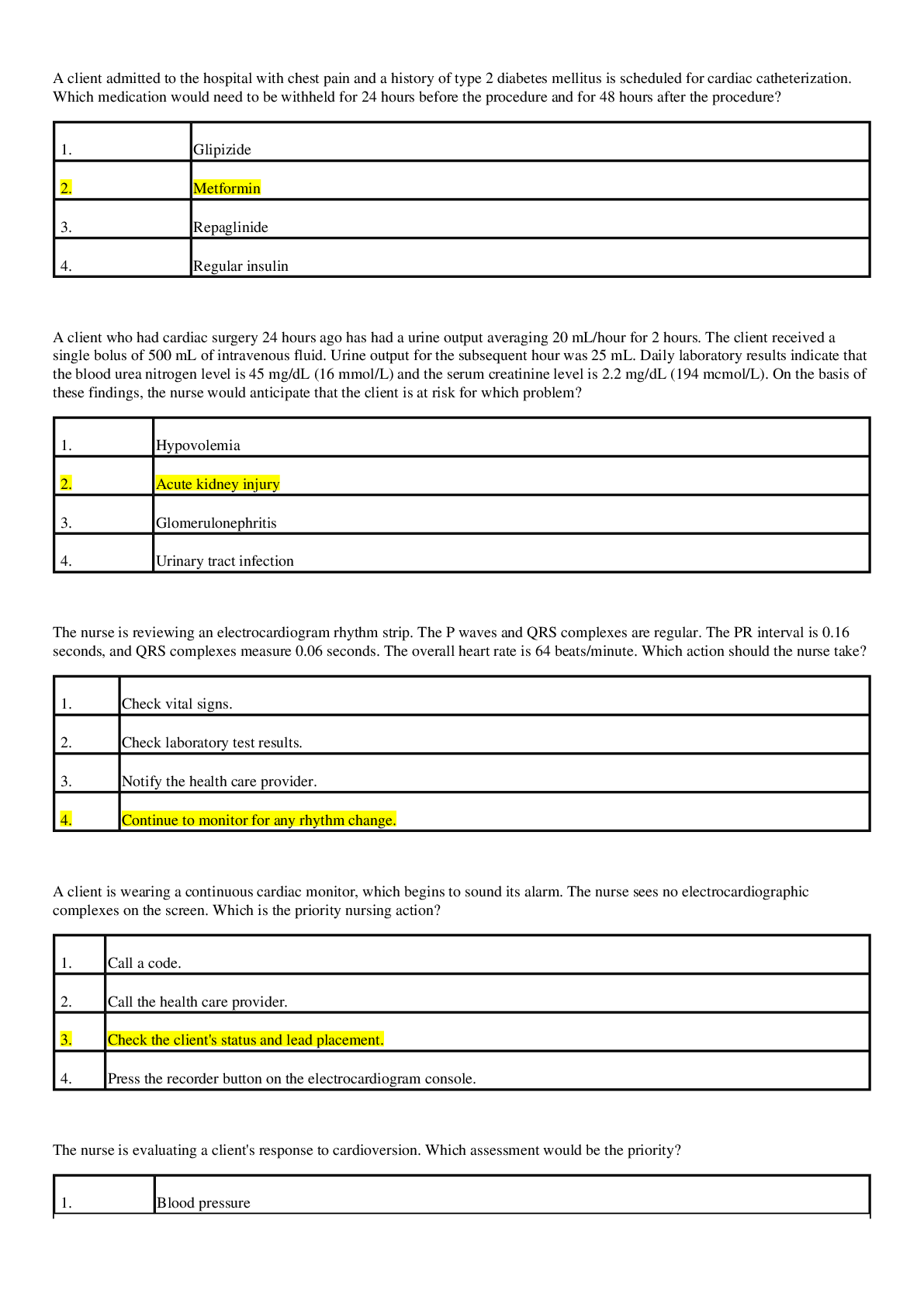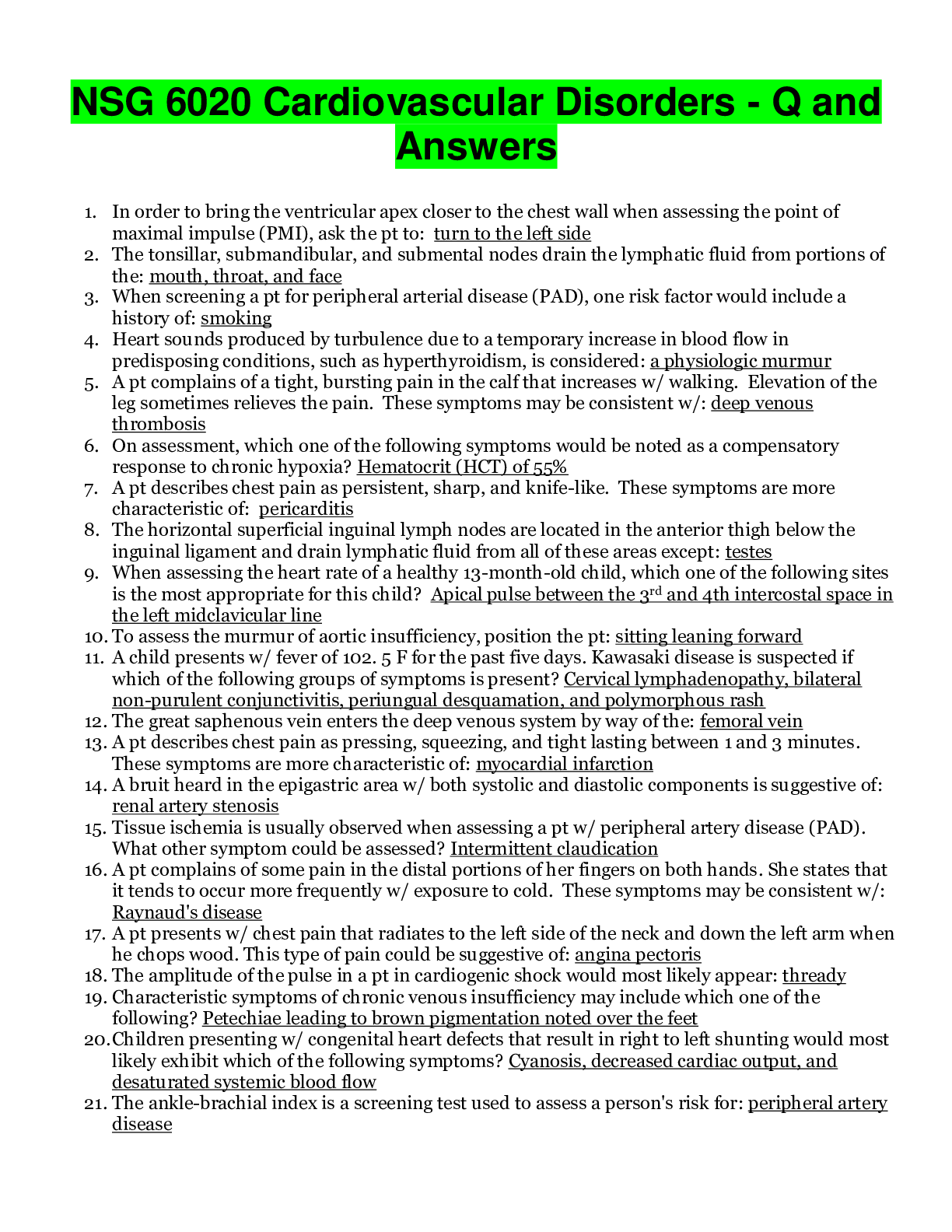RNSG RNSG 1250 Respiratory Nclex Q and A
Document Content and Description Below
P a g e | 1 NCLEX Q A Respiratory The nurse is assessing the functioning of a chest tube drainage system in a client who has just returned from the recovery room following a thoracotomy with wedge ... resection. Which are the expected assessment findings? Select all that apply. 1. Excessive bubbling in the water seal chamber 2. Vigorous bubbling in the suction control chamber 3. Drainage system maintained below the client's chest 4. 50 mL of drainage in the drainage collection chamber 5. Occlusive dressing in place over the chest tube insertion site 6. Fluctuation of water in the tube in the water seal chamber during inhalation and exhalation The nurse is assisting a health care provider with the removal of a chest tube. The nurse should instruct the client to take which action? 1. Stay very still. 2. Exhale very quickly. 3. Inhale and exhale quickly. 4. Perform the Valsalva maneuver. The nurse caring for a client with a pneumothorax and who has had a chest tube inserted notes continuous gentle bubbling in the water seal chamber. What action is most appropriate? 1. Do nothing, because this is an expected finding. 2. Check for an air leak, because the bubbling should be intermittent. 3. Increase the suction pressure so that the bubbling becomes vigorous. 4. Clamp the chest tube and notify the health care provider immediately. The nurse is caring for a client who suffered an inhalation injury from a wood stove. The carbon monoxide blood report reveals a level of 12%. Based on this level, the nurse would anticipate noting which sign in the client? 1. Coma 2. Flushing 3. Dizziness 4. Tachycardia Rationale: Carbon monoxide levels between 11% and 20% result in flushing, headache, decreased visual activity, decreased cerebral functioning, and slight breathlessness; levels of 21% to 40% result in nausea, vomiting, dizziness, tinnitus, vertigo, confusion, drowsiness, pale to reddish-purple skin, and tachycardia; levels of 41% to 60% result in seizure and coma; and levels higher than 60% result in death. The emergency department nurse is assessing a client who has sustained a blunt injury to the chest wall. Which finding indicates the presence of a pneumothorax in this client? P a g e | 2 1. A low respiratory rate 2. Diminished breath sounds 3. The presence of a barrel chest 4. A sucking sound at the site of injury Rationale: This client has sustained a blunt or closed-chest injury. Basic symptoms of a closed pneumothorax are shortness of breath and chest pain. A larger pneumothorax may cause tachypnea, cyanosis, diminished breath sounds, and subcutaneous emphysema. Hyperresonance also may occur on the affected side. A sucking sound at the site of injury would be noted with an open chest injury. The nurse is caring for a client hospitalized with acute exacerbation of chronic obstructive pulmonary disease. Which findings would the nurse expect to note on assessment of this client? Select all that apply. 1. A low arterial PCo2 level 2. A hyperinflated chest noted on the chest x-ray 3. Decreased oxygen saturation with mild exercise 4. A widened diaphragm noted on the chest x-ray 5. Pulmonary function tests that demonstrate increased vital capacity The nurse instructs a client to use the pursed-lip method of breathing and evaluates the teaching by asking the client about the purpose of this type of breathing. The nurse determines that the client understands if the client states that the primary purpose of pursed-lip breathing is to promote which outcome? 1. Promote oxygen intake. 2. Strengthen the diaphragm. 3. Strengthen the intercostal muscles. 4. Promote carbon dioxide elimination. The nurse is preparing a list of home care instructions for a client who has been hospitalized and treated for tuberculosis. Which instructions should the nurse include on the list? Select all that apply. 1. Activities should be resumed gradually. 2. Avoid contact with other individuals, except family members, for at least 6 months. 3. A sputum culture is needed every 2 to 4 weeks once medication therapy is initiated. 4. Respiratory isolation is not necessary because family members already have been exposed. 5. Cover the mouth and nose when coughing or sneezing and put used tissues in plastic bags. 6. When 1 sputum culture is negative, the client is no longer considered infectious and usually can return to former employment. P a g e | 3 The nurse is caring for a client after a bronchoscopy and biopsy. Which finding, if noted in the client, should be reported immediately to the health care provider? 1. Dry cough 2. Hematuria 3. Bronchospasm 4. Blood-streaked sputum Rationale: If a biopsy was performed during a bronchoscopy, blood-streaked sputum is expected for several hours. Frank blood indicates hemorrhage. A dry cough may be expected. The client should be assessed for signs of complications, which would include cyanosis, dyspnea, stridor, bronchospasm, hemoptysis, hypotension, tachycardia, and dysrhythmias. Hematuria is unrelated to this procedure. The nurse is preparing to suction a client via a tracheostomy tube. The nurse should plan to limit the suctioning time to a maximum of which time period? 1. 5 seconds 2. 10 seconds 3. 30 seconds 4. 60 seconds The nurse is suctioning a client via an endotracheal tube. During the suctioning procedure, the nurse notes on the monitor that the heart rate is decreasing. Which nursing intervention is appropriate? 1. Continue to suction. 2. Notify the health care provider immediately. 3. Stop the procedure and reoxygenate the client. 4. Ensure that the suction is limited to 15 seconds. The nurse is assessing the respiratory status of a client who has suffered a fractured rib. The nurse should expect to note which finding? 1. Slow, deep respirations 2. Rapid, deep respirations 3. Paradoxical respirations 4. Pain, especially with inspiration A client with a chest injury has suffered flail chest. The nurse assesses the client for which most distinctive sign of flail chest? 1. Cyanosis 2. Hypotension 3. Paradoxical chest movement 4. Dyspnea, especially on exhalation P a g e | 4 The nurse is assessing a client with multiple trauma who is at risk for developing acute respiratory distress syndrome. The nurse should assess for which earliest sign of acute respiratory distress syndrome? 1. Bilateral wheezing 2. Inspiratory crackles 3. Intercostal retractions 4. Increased respiratory rate The nurse has conducted discharge teaching with a client diagnosed with tuberculosis who has been receiving medication for 2 weeks. The nurse determines that the client has understood the information if the client makes which statement? 1. "I need to continue medication therapy for 1 month." 2. "I can't shop at the mall for the next 6 months." 3. "I can return to work if a sputum culture comes back negative." 4. "I should not be contagious after 2 to 3 weeks of medication therapy." A client has experienced pulmonary embolism. The nurse should assess for which symptom, which is most commonly reported? 1. Hot, flushed feeling 2. Sudden chills and fever 3. Chest pain that occurs suddenly 4. Dyspnea when deep breaths are taken A client who is human immunodeficiency virus (HIV)–positive has had a tuberculin skin test (TST). The nurse notes a 7-mm area of induration at the site of the skin test and interprets the result as which finding? 1. Positive 2. Negative 3. Inconclusive 4. Need for repeat testing A client with acquired immunodeficiency syndrome (AIDS) has histoplasmosis. The nurse should assess the client for which expected finding? 1. Dyspnea 2. Headache 3. Weight gain 4. Hypothermia Rationale: Histoplasmosis is an opportunistic fungal infection that can occur in the client with AIDS. The infection begins as a respiratory infection and can progress to disseminated infection. Typical signs and symptoms include fever, dyspnea, cough, and weight loss. Enlargement of the client's lymph nodes, liver, and spleen may occur as well. P a g e | 5 The nurse is giving discharge instructions to a client with pulmonary sarcoidosis. The nurse concludes that the client understands the information if the client indicates to report which early sign of exacerbation? 1. Fever 2. Fatigue 3. Weight loss 4. Shortness of breath Rationale: Dry cough and dyspnea are typical early manifestations of pulmonary sarcoidosis. Later manifestations include night sweats, fever, weight loss, and skin nodules. The nurse is taking the history of a client with occupational lung disease (silicosis). The nurse should assess whether the client wears which item during periods of exposure to silica particles? 1. Mask 2. Gown 3. Gloves 4. Eye protection An oxygen delivery system is prescribed for a client with chronic obstructive pulmonary disease to deliver a precise oxygen concentration. Which oxygen delivery system would the nurse prepare for the client? 1. Face tent 2. Venturi mask 3. Aerosol mask 4. Tracheostomy collar The nurse is instructing a hospitalized client with a diagnosis of emphysema about measures that will enhance the effectiveness of breathing during dyspneic periods. Which position should the nurse instruct the client to assume? 1. Sitting up in bed 2. Side-lying in bed 3. Sitting in a recliner chair 4. Sitting up and leaning on an overbed table The community health nurse is conducting an educational session with community members regarding the signs and symptoms associated with tuberculosis. The nurse informs the participants that tuberculosis is considered as a diagnosis if which signs and symptoms are present? Select all that apply. 1. Dyspnea 2. Headache 3. Night sweats 4. A bloody, productive cough 5. A cough with the expectoration of mucoid sputum P a g e | 6 The nurse performs an admission assessment on a client with a diagnosis of tuberculosis. The nurse should check the results of which diagnostic test that will confirm this diagnosis? 1. Chest x-ray 2. Bronchoscopy 3. Sputum culture 4. Tuberculin skin test The nurse is teaching a client with emphysema about positions that help breathing during dyspneic episodes. The nurse instructs the client that which positions alleviate dyspnea? Select all that apply. 1. Sitting up and leaning on a table 2. Standing and leaning against a wall 3. Lying supine with the feet elevated 4. Sitting up with the elbows resting on knees 5. Lying on the back in a low Fowler's position A client is returned to the nursing unit after thoracic surgery with chest tubes in place. During the first few hours postoperatively, what type of drainage should the nurse expect? 1. Serous 2. Bloody 3. Serosanguineous 4. Bloody, with frequent small clots The nurse is preparing to care for a client who will be weaned from a cuffed tracheostomy tube. The nurse is planning to use a tracheostomy plug and plans to insert it into the opening in the outer cannula. Which nursing action is required before plugging the tube? 1. Deflate the cuff on the tube. 2. Place the inner cannula into the tube. 3. Ensure that the client is able to speak. 4. Ensure that the client is able to swallow. The nurse is caring for a client who is on strict bed rest and creates a plan of care with goals related to the prevention of deep vein thrombosis and pulmonary emboli. Which nursing action is most helpful in preventing these disorders from developing? 1. Restricting fluids 2. Placing a pillow under the knees 3. Encouraging active range-of-motion exercises 4. Applying a heating pad to the lower extremities P a g e | 7 The nurse is monitoring the chest tube drainage system in a client with a chest tube. The nurse notes intermittent bubbling in the water seal chamber. Which is the most appropriate nursing action? 1. Check for an air leak. 2. Document the findings. 3. Notify the health care provider. 4. Change the chest tube drainage system. The nurse is monitoring the chest tube drainage system in a client with a chest tube. The nurse notes constant bubbling in the water seal chamber. Which is the most appropriate initial nursing action? 1. Continue to monitor. 2. Document the findings. 3. Change the chest tube drainage system. 4. Perform a focused respiratory assessment. The nurse is caring for a client who is mechanically ventilated and is monitoring for complications of mechanical ventilation. Which assessment finding, if noted by the nurse, indicates the need for follow-up? 1. Muscle weakness in the arms and legs 2. A temperature of 98.6°F (37°C), decreased from 99.0°F (37.2°C) 3. A blood pressure of 90/60 mm Hg, decreased from 112/78 mm Hg 4. A heart rate of 80 beats/minute, decreased from 85 beats/minute The nurse has assisted a health care provider (HCP) with the insertion of a chest tube. The nurse monitors the client and notes fluctuation of the fluid level in the water seal chamber after the tube is inserted. Based on this assessment finding, which action is most appropriate? 1. Inform the HCP. 2. Continue to monitor the client. 3. Reinforce the occlusive dressing. 4. Encourage the client to deep breathe. 33 The nurse has assisted the health care provider and the anesthesiologist with placement of an endotracheal (ET) tube for a client in respiratory distress. What is the initial nursing action to evaluate proper ET tube placement? 1. Tape the ET tube in place, and note the centimeter marking at the lip line. 2. Ask the radiology department to obtain a stat portable radiograph at the client's bedside. 3. Use an Ambu (resuscitation) bag to ventilate the client and assess for bilateral breath sounds. 4. Attach the ET tube to the ventilator and determine whether the client is able to tolerate the tidal volume prescribed. P a g e | 8 The nurse is preparing to perform suctioning for a client with a tracheostomy tube and gathers the supplies needed for the procedure. What is the initial nursing action? 1. Hyper oxygenate the client. 2. Set the suction pressure range at 150 mm Hg. 3. Place the catheter into the tracheostomy tube. 4. Apply suction on the catheter and insert it into the tracheostomy tube. The nursing instructor is observing a nursing student suctioning a client through a tracheostomy tube. Which observation by the nursing instructor indicates an action by the student requiring the need for further instruction? 1. Suctioning the client every hour 2. Applying suction only during withdrawal of the catheter 3. Hyperventilating the client with 100% oxygen before suctioning 4. Applying suction intermittently during withdrawal of the catheter The nurse is changing the tracheostomy ties on a client with a tracheostomy and is assessing the security of the ties. Which method is used to ensure that the ties are not too tightly placed? 1. The ties leave no marks on the neck. 2. The tracheotomy can be pulled slightly away from the neck. 3. The nurse places 1 finger loosely between the tie and the neck. 4. The nurse uses a 12-inch tie that is tightly affixed with hook-and-loop closures. The nurse is preparing for removal of an endotracheal (ET) tube from a client. In assisting the health care provider with this procedure, which is the initial nursing action? 1. Deflate the cuff. 2. Suction the ET tube. 3. Turn off the ventilator. 4. Obtain a code cart and place it at the bedside. The nurse is caring for a client who is mechanically ventilated, and the high-pressure ventilator alarm is sounding. The nurse understands that which complications may cause this alarm? Select all that apply. 1. Water or a kink in the tubing 2. Biting on the endotracheal tube 3. Increased secretions in the airway 4. Disconnection or leak in the system 5. The client ceasing spontaneous breathing Rationale: Causes of high-pressure ventilator alarms include water or a kink in the tubing, biting on the endotracheal tube, increased secretions in the airway, wheezing or bronchospasm, displacement of the endotracheal tube, or the P a g e | 9 client fighting the ventilator. A disconnection or leak in the system and the client ceasing to spontaneously breathe are causes of a low-pressure ventilator alarm. The nurse is performing nasotracheal suctioning of a client. The nurse determines that the client is tolerating the procedure if which observation is made? 1. The skin color becomes cyanotic. 2. Secretions are becoming bloody. 3. Coughing occurs with suctioning. 4. Heart rate decreases from 78 to 54 beats/minute. Rationale: The nurse monitors for adverse effects of suctioning, which include cyanosis, excessively rapid or slow heart rate, and sudden development of bloody secretions. If any of these signs is observed, the nurse immediately stops suctioning and reports the adverse effect to the health care provider. Coughing is a normal response to suctioning for the client with an intact cough reflex and does not indicate that he or she cannot tolerate the procedure. A client with a tracheostomy tube who is on a ventilator is at risk for impaired gas exchange. The nurse should assess for which finding as the best indicator of adequate ongoing respiratory status? 1. Oxygen saturation of 89% 2. Respiratory rate of 16 breaths/minute 3. Moderate amounts of tracheobronchial secretions 4. Small to moderate amounts of frank blood suctioned from the tube The nurse is monitoring the respiratory status of a client after creation of a tracheostomy. Which co-existing condition in the client may cause an inaccurate pulse oximetry reading? 1. Fever 2. Epilepsy 3. Hypotension 4. Respiratory failure The nurse is monitoring the function of a client's chest tube that is attached to a drainage system. The nurse notes that the fluid in the water seal chamber rises with inspiration and falls with expiration. The nurse determines that which is occurring? 1. Tidaling is present. 2. There is a leak in the system. 3. The client has residual pneumothorax. 4. Suction should be added to the system. Rationale: When the chest tube is patent, the fluid in the water seal chamber rises with inspiration and falls with expiration. This is referred to as tidaling and indicates proper function of the system. Options 2, 3, and 4 are inaccurate interpretations. A client is diagnosed with a rib fracture and asks the nurse why strapping of the ribs is not being done. Which response by the nurse is most appropriate? P a g e | 10 1. "Strapping is useful only if the ribs are fractured in several places at once." 2. "That's a good idea. I'll ask the health care provider for a prescription for the needed supplies." 3. "That isn't done because people often would develop pneumonia from the constricting effect on the lungs." 4. "That might help you to breathe better, but this facility does not carry the necessary supplies in the stockroom. When you get home, you can purchase them at the medical supply store." The nurse is caring for a postoperative pneumonectomy client. Which finding on assessment of the client is an adverse sign or symptom indicating pulmonary edema? 1. Pain with deep breathing 2. Increased chest tube drainage 3. Lung crackles in the remaining lung 4. Respiratory rate of 20 breaths/minute The nurse reads that a client's tuberculin skin test is positive and notes that previous tests were negative. The client becomes upset and asks the nurse what this means. The nurse should base the response on which interpretation? 1. Systemic tuberculosis 2. Pulmonary tuberculosis 3. Exposure to tuberculosis 4. No evidence of tuberculosis The nurse is caring for a client with tuberculosis (TB) who is fearful of the disease and anxious about the prognosis. In planning nursing care, the nurse should incorporate which intervention as the best strategy to assist the client in coping with the illness? 1. Allow the client to deal with the disease in an individual fashion. 2. Ask family members whether they wish a psychiatric consultation. 3. Encourage the client to visit with the pastoral care department's chaplain. 4. Provide reassurance that continued compliance with medication therapy is the most proactive way to cope with the disease. A client diagnosed with tuberculosis (TB) is distressed over fatigue and the loss of physical stamina. What should the nurse tell the client? 1. This is expected and will last for at least 1 year. 2. This is expected, and the client should gradually increase activity as tolerated. 3. This is an unexpected finding with TB, but it should resolve within 1 month or so. 4. This is a short-lived problem that should be gone within 1 week after beginning medication therapy. P a g e | 11 The nurse is assessing a client with the typical clinical manifestations of tuberculosis (TB). During history-taking the nurse anticipates that the client will report presence of cough and fatigue for what period of time? 1. 1 or 2 days 2. 1 to 2 weeks 3. Almost 1 week 4. Several weeks to months The nurse is preparing for suctioning an unconscious client who has a tracheostomy. The nurse should perform which actions for this procedure? Select all that apply. 1. Keeping a supply of suction catheters at the bedside 2. Auscultating breath sounds to determine the need for suctioning 3. Hyper oxygenating the client before, during, and after suctioning 4. Intermittently suctioning during insertion of the suction catheter 5. Placing suction on the catheter for at least 30 seconds to ensure that all secretions are removed The clinic nurse administers a tuberculin skin test to a client. The nurse tells the client to return to the clinic for the results in how long? 1. 6 to 12 hours 2. 12 to 24 hours 3. 24 to 28 hours 4. 48 to 72 hours A client who has undergone radical neck dissection for a tumor has a potential problem of obstruction related to postoperative edema, drainage, and secretions. To promote adequate respiratory function in this client, the nurse should implement which activities? Select all that apply. 1. Suctioning the client as needed 2. Encouraging coughing every 2 hours 3. Placing the bed in low Fowler's position 4. Supporting the neck incision when the client coughs 5. Monitoring the respiratory status frequently as prescribed The clinic nurse is providing instructions to a client with a diagnosis of pharyngitis. The nurse provides which instruction to the client? 1. Drink hot tea throughout the day. 2. Drink hot cocoa instead of coffee. 3. Restrict fluid intake to 1000 mL daily. 4. Eat foods that are highly seasoned in moderation. P a g e | 12 A client arrives in the hospital emergency department with a bloody nose. What is the initial nursing action? 1. Place the client in supine position. 2. Apply an ice collar around the client's neck. 3. Assist the client to a sitting position with the head tilted forward. 4. Instruct the client to swallow the blood until the bleeding can be controlled. The nurse is caring for a client with a tracheostomy tube who is receiving mechanical ventilation. The nurse is monitoring for complications related to the tracheostomy and suspects tracheoesophageal fistula when which occurs? 1. Suctioning is required frequently. 2. The client's skin and mucous membranes are light pink. 3. Aspiration of gastric contents occurs during suctioning. 4. Excessive secretions are suctioned from the tube and stoma. The nurse is caring for a client on a mechanical ventilator. The high-pressure alarm sounds. The nurse assesses the client and attempts to determine the cause of the alarm. Which initialnursing action would be appropriate if the nurse is unable to determine the cause of ventilator alarm? 1. Shut the alarm off and call for help. 2. Call the respiratory therapy department to fix the problem. 3. Call the health care provider (HCP) for further instructions. 4. Disconnect the client from the ventilator and manually ventilate the client with a resuscitation device. The nurse is caring for a client with an endotracheal tube attached to a mechanical ventilator. The high-pressure alarm sounds, and the nurse assesses the client. The nurse determines that the cause of the alarm is most likely to be due to which complication? 1. A kink in the ventilator circuit 2. A leak in the endotracheal tube cuff 3. Displacement of the endotracheal tube 4. A disconnection of the ventilator tubing A health care provider (HCP) writes a prescription to begin to wean the client from the mechanical ventilator by use of intermittent mandatory ventilation/synchronized intermittent mandatory ventilation (IMV/SIMV). The registered nurse determines that the new graduate nurse understands this modality of weaning if which statement is made? 1. "The respiratory rate is decreased gradually until the client can assume the work of breathing without ventilatory assistance." 2. "A T-piece will be attached to the ventilator and provide supplemental oxygen at a concentration that is 10% higher than the ventilator setting." 3. "It will provide pressure support to decrease the workload of breathing and increase P a g e | 13 the client's ability to initiate spontaneous breathing efforts." 4. "It involves removing the ventilator from the client and closely monitoring the client's ability to breathe spontaneously for a predetermined amount of time." The nurse is preparing to wean a client from a ventilator by the use of a T-piece. Which would be a component of the plan of care with this type of weaning process? Select all that apply. 1. Pressure support is added to the oxygen system. 2. The T-piece is connected to the client's artificial airway. 3. The client is removed from the mechanical ventilator for a short period of time. 4. The respiratory rate on the ventilator is gradually decreased until the client can do all of the work of breathing on his or her own. 5. Supplemental oxygen is provided through the T-piece at a fraction of inspired oxygen (FiO2) that is 10% higher than a ventilator setting. The nurse is reviewing the ventilator settings on a client with an endotracheal tube attached to mechanical ventilation. The nurse notes that the tidal volume is set at 700 mL. How does the nurse interpret this setting? 1. It is the amount of air delivered with each set breath. 2. It is a breath that has a greater volume than the preset tidal volume. 3. It is the number of breaths that the client will receive per minute by the ventilator. 4. It is the fraction of inspired oxygen (FiO2) that is delivered to the client through the ventilator. The nurse is providing an educational session to community members regarding histoplasmosis. The nurse should provide which information about this disease? 1. It is caused by a tick bite. 2. It is caused by contamination from cat feces. 3. It can be caused by the inhalation of spores from bird droppings. 4. It can be contagious by respiratory contact with an infected person. A health care provider (HCP) tells the nurse that a client's chest tube is to be removed. The nurse should bring which dressing materials to the bedside for the HCP's use? 1. Telfa dressing and Neosporin ointment 2. Petrolatum gauze and sterile 4 × 4 gauze 3. Benzoin spray and a hydrocolloid dressing 4. Sterile 4 × 4 gauze, Neosporin ointment, and tape P a g e | 14 The nurse enters a client's room with a pulse oximetry machine and tells the client that the health care provider (HCP) has prescribed continuous oxygen saturation readings. The client's facial expression changes to one of apprehension. The nurse can alleviate the client's anxiety by providing which information about pulse oximetry? 1. It is painless and safe. 2. It causes only mild discomfort at the site. 3. It requires insertion of only a very small catheter. 4. It has an alarm to signal dangerous drops in oxygen saturation levels. A young adult client has never had a chest x-ray before and expresses to the nurse a fear of experiencing some form of harm from the test. Which statement by the nurse provides valid reassurance to the client? 1. "You'll wear a lead shield to partially protect your organs from harm." 2. "The amount of x-ray exposure is not sufficient to cause DNA damage." 3. "The test isn't harmful at all. The most frustrating part is the long wait in radiology." 4. "The x-ray exam itself is painless, and a lead shield protects you from the minimal radiation." The nurse is developing a plan of care for a client at risk for acute respiratory distress syndrome (ARDS). As part of the plan, the nurse will assess for which sign or symptom for early detection of this disorder? 1. Edema 2. Dyspnea 3. Frothy sputum 4. Diminished breath sounds The nurse caring for a client with a closed chest drainage system notes that the fluctuation (tidaling) in the water seal chamber has stopped. On the basis of this assessment finding, the nurse would suspect which occurrence? 1. The system needs changing. 2. Suction needs to be increased. 3. Suction needs to be decreased. 4. The chest tube may be obstructed. The nurse is providing instructions to a client being discharged from the hospital following removal of a chest tube that was inserted after thoracic surgery. Which statement made by the client indicates a need for further teaching? 1. "I should avoid heavy lifting for at least 4 to 6 weeks." 2. "I should remove the chest tube site dressing as soon as I get home." 3. "If I have any difficulty breathing, I should call the health care provider." 4. "If I note any signs of infection, I should contact the health care provider." P a g e | 15 The nurse is preparing to assist a client with a cuffed tracheostomy tube to eat. What intervention is the priority before the client is permitted to drink or eat? 1. Inflate the cuff on the tracheostomy tube. 2. Deflate the cuff on the tracheostomy tube. 3. Maintain the head of the bed in low Fowler's position. 4. Place the tray in a comfortable position in front of the client. Rationale: Tracheostomy tubes are available in many sizes and are made of plastic or metal. The tubes may be reusable; however, most tubes are disposable. A tracheostomy tube may or may not have a cuff. It also may have an inner cannula. For clients receiving mechanical ventilation, a cuffed tube is used. A noncuffed tube may be used when mechanical ventilation is not required. If a client with a tracheostomy is allowed to eat and the tracheostomy has a cuff, the nurse should inflate the cuff to prevent aspiration of food or fluids. The cuff would not be deflated because of the risk of aspiration. Although the nurse would ensure that the meal tray is in a comfortable position for the client, this would not be the priority intervention. The head of the bed should always be elevated; low Fowler's position could lead to aspiration. The nurse has provided discharge instructions to the client who has had a pneumonectomy. Which statement, if made by the client, indicates an understanding of appropriate home care measures? 1. "I should restrict my fluid intake for 2 weeks." 2. "I should perform arm exercises 2 or 3 times a day." 3. "If I experience any soreness in my chest or shoulder, I should notify the health care provider." 4. "If I experience any numbness or altered sensation around the incision, I should contact the health care provider." Rationale: The client should be instructed to perform arm and shoulder exercises 2 or 3 times a day to prevent frozen shoulder. The client is encouraged to drink liquids to liquefy secretions, making them easier to expectorate. The client is told to expect soreness in the chest and shoulder and an altered feeling of sensation around the incision site for several weeks. It is not necessary to contact the health care provider if these symptoms occur. A client with a history of recent upper respiratory infection comes to the urgent care center complaining of chest pain. The nurse determines that the pain is most likely of a respiratory origin if the client makes which statement about the pain? 1. "It hurts more when I breathe in." 2. "I have never had this pain before." 3. "It hurts on the left side of my chest." 4. "The pain is about a 6 on a scale of 1 to 10." A client with a fat embolus is experiencing respiratory distress. The nurse plans to assist with which therapies? 1. Administration of plasma expanders, low-flow oxygen, and suctioning 2. Administration of bronchodilators, intubation, and mechanical ventilation 3. Administration of oxygen, intubation, and mechanical ventilation with positive end- P a g e | 16 expiratory pressure 4. Administration of antihypertensives, high-flow oxygen, and continuous positive airway pressure mask The nurse is caring for a client on a mechanical ventilator. The low-pressure alarm sounds. The nurse suspects that the most likely cause of the alarm is which finding? 1. A tubing obstruction or kink 2. The accumulation of secretions 3. Disconnection of the ventilator tubing 4. Condensation of water in the ventilator tubing A client who experiences frequent upper respiratory infections (URIs) asks the nurse why food does not seem to have any taste during illness. Which response by the nurse is most appropriate? 1. "You lack the energy to cook wholesome meals." 2. "Blocked nasal passages impair the sense of smell." 3. "Loss of appetite is triggered by the infectious organism." 4. "Infection blocks sensation in the taste buds of the tongue." A registered nurse who is orienting a new nursing graduate to the hospital emergency department instructs the new graduate to monitor a client for one-sided chest movement on the right side while the client is being intubated by the health care provider (HCP). Which statement made by the new nursing graduate indicates understanding of the importance of this observation? 1. "It will enter the left main bronchus if inserted too far." 2. "It will enter the right main bronchus if inserted too far." 3. "It may enter the left main bronchus if not inserted far enough." 4. "It may enter the right main bronchus if not inserted far enough." A client who is mouth breathing is receiving oxygen by face mask. The unlicensed assistive personnel (UAP) asks the registered nurse (RN) why a water bottle is attached to the oxygen tubing near the wall oxygen outlet. The RN responds that this feature facilitates which purpose? 1. Prevents the client from getting a nosebleed 2. Gives the client added fluid via the respiratory tree 3. Humidifies the oxygen that is bypassing the client's nose 4. Prevents fluid loss from the lungs during mouth breathing The nurse is reinforcing instructions to a client about the use of an incentive spirometer. The nurse tells the client to sustain the inhaled breath for 3 seconds. When the client asks the nurse about the rationale for this action, the nurse explains that which is the primary benefit? P a g e | 17 1. Dilate the major bronchi. 2. Increase surfactant production. 3. Maintain inflation of the alveoli. 4. Enhance ciliary action in the tracheobronchial tree. The nurse and an unlicensed assistive personnel (UAP) are assisting the respiratory therapist to position a client for postural drainage. The UAP asks the nurse how the respiratory therapist selects the position to be used for the procedure. The nurse responds that a position is chosen that will use gravity to help drain secretions from which primary areas? 1. Lobes 2. Alveoli 3. Trachea 4. Main bronchi A client who is experiencing respiratory difficulty asks the nurse, "Why it is so much easier to breathe out than in?" In providing a response, the nurse explains that breathing is easier on exhalation because of which respiratory responses? 1. Air flows by gravity. 2. The respiratory muscles relax. 3. The respiratory muscles contract. 4. Air is flowing against a pressure gradient. [Show More]
Last updated: 1 year ago
Preview 1 out of 17 pages
Instant download
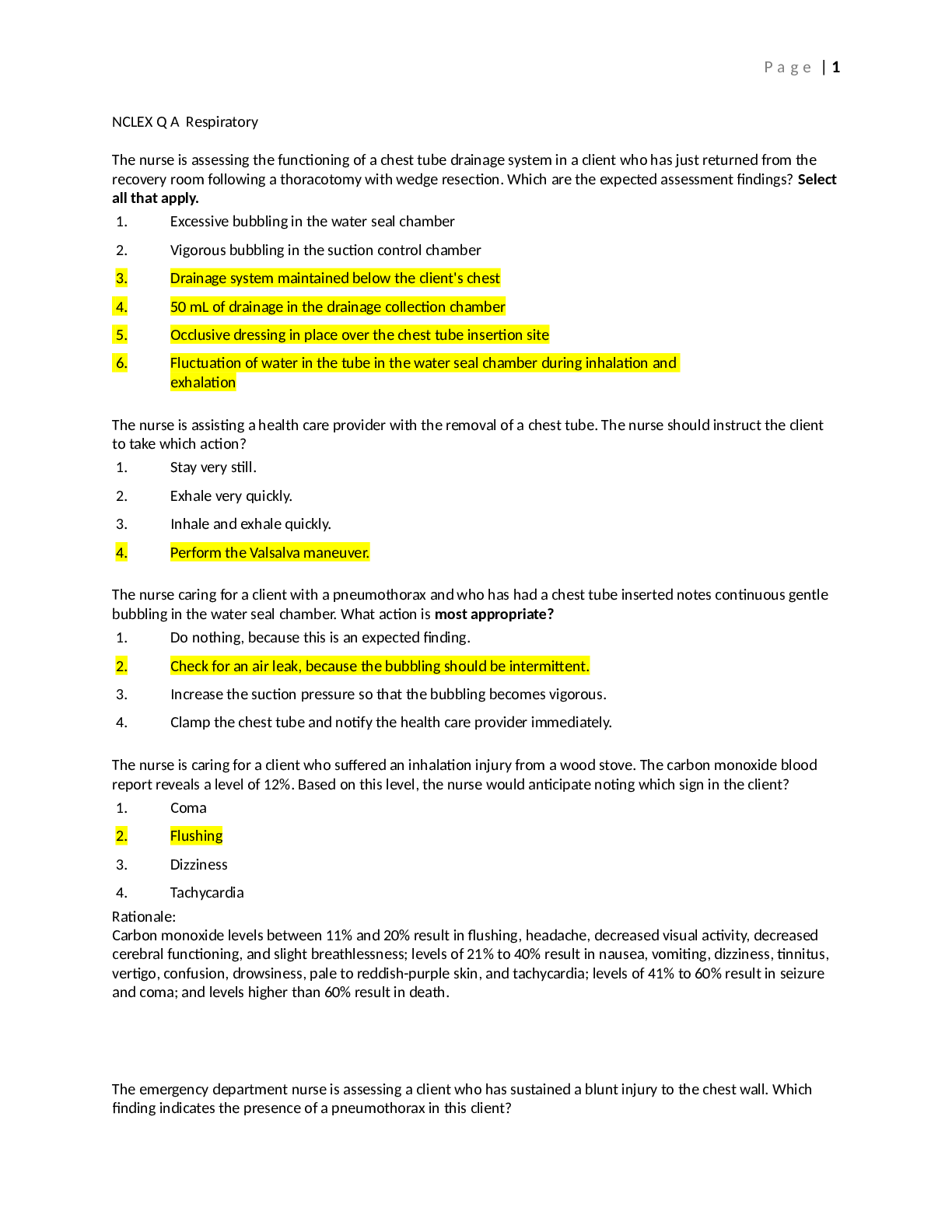
Buy this document to get the full access instantly
Instant Download Access after purchase
Add to cartInstant download
Reviews( 0 )
Document information
Connected school, study & course
About the document
Uploaded On
Oct 13, 2021
Number of pages
17
Written in
Additional information
This document has been written for:
Uploaded
Oct 13, 2021
Downloads
0
Views
289

.png)
